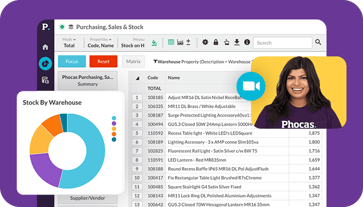Making good purchasing decisions requires business intelligence
Smart purchasing and stock optimization boosts your organization’s bottom line. What am I buying, selling, holding and what’s the cost? It’s a messy ask, report-wise. If you’re involved in purchasing decisions, you don’t care so much about who’s buying your product. It’s more about what’s walking out the door, and how fast, so you can replenish it. Business intelligence allows you to be in control of your data and know at any point in time; what stock is on hand, what's been ordered and days of cover.
You want product in the right location to meet demand efficiently, which means stock warehoused according to sales. You’re thinking:
- What stock do I need to buy for each part of the national business?
- How frequently?
- Where do I put it?
- And how do I work that out with my standard ERP reporting solution?
Silo reporting
Sales, purchasing and the warehouse generally work independently and don’t share the data that can make a business function more efficiently.
You get a sales report that talks about customers and territories and sales reps, but lacks product level and location information. You get a purchasing report that tells you a lot about individual product and suppliers, but nothing about frequency of sales by territory.
And Sales needs to know about Purchasing’s activities. They need to know:
- what’s coming
- what’s already committed
- if something’s completely out of stock (it may take longer now to ship from overseas- say 8 weeks instead of 5).
You risk losing customers if you can’t satisfy orders. It all ties back to sharing information. But if you're using more than one system and the data isn't synced into one source, this can prove difficult.
Snappy reporting
In a perfect world where everyone has what they need all of the time … you get a daily report that shows you:
- how much stock you’ve bought
- over various periods (month-to-date, financial-year-to-date etc.)
- in what quantities
- at what cost
- who supplied it
- to which location
- and how much you received.
You click to the next page and find, to your great amazement:
- what’s being sold
- from which product groups
- and which locations
- how much is left in those locations
- and if that covers pre-orders and standing orders.
Excited, you click through and, lo and behold, there are figures on:
- dead stock
- slow-moving stock
- and inventory turns.
At this point, you can’t believe your standard reporting system could be so kind. It isn’t. But this is what a business intelligence solution can deliver.
Poor inventory management costs – lots
Besides any frustrations you may have around how long it takes to get the big picture view, and how easy it is to digest it once delivered, there’s the matter of what it costs you to stay in the dark.
If you’re achieving $US20 million in annual sales with an inventory of $US4 million, you’re looking at:

How you go about cost effective inventory management is possible when you have the right tools at hand.
Find a unicorn or start using business intelligence
You could put your efforts into finding a unicorn – that one person in the organization who has all that information and is free, any time, to share it with you.
Or you could start looking at a business intelligence solution that offers easy, self-serve data analytics.
Then you can query your data, based on your own train of thought to get the answers you need to make decisions right now. And share those calculations and decisions with others immediately.
Purchasing is just one area where you can find value from your business data and to make good purchasing decisions.


Empowering businesses with intuitive data analytics, driving informed decisions for growth and profitability. We make people feel good about data.
Related blog posts

DIFOT (Delivered In-Full, On-Time) or OTIF (On-Time In-Full) is a fundamental KPI when analyzing the performance of your supply chain. The main goal is to get your customers the products they need, when they need them, in the quantity they ordered. DIFOT measures how successful your business is at achieving this objective and identifies procurement problems and supplier reliability.
Read more
Picture a football coach preparing for the big game. He watches game‑tape, studying player metrics, analyzing every play and using real‑time stats to inform strategy. That’s exactly how sales managers and sales leaders should approach their coaching program—with a data‑driven approach.
Read more
Sales professionals operate in face-paced environments with savvy customers who have a lot of choice. Whether you're in B2B sales or working with consumers, the sales process is challenging with longer sales cycles, more decision-makers and higher expectations for follow-up and advice. To stay competitive, sales reps and sales teams need the best sales tools to reduce administrative tasks and improve sales team performance.
Read more
“Free BI tools trial, business analytics software for free, free BI reporting with AI-powered insights”– these offers are tempting business people all the time especially as new open-source players enter the market and want cut-through.
Read moreBrowse by category

Find out how our platform gives you the visibility you need to get more done.
Get your demo today